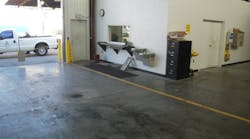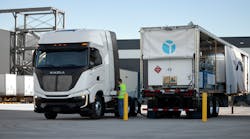More fleets are realizing the financial and environmental benefits of operating natural gas vehicles (NGVs). As NGVs are incorporated into a fleet, it’s just as important to realize that some potentially significant maintenance facility modifications likely need to take place.
“Many fleet maintenance facilities were built long before the advent of using natural gas as a vehicle fuel,” says Leo Thomason, executive director of the Natural Gas Vehicle Institute (NGVi), which provides natural gas vehicle technical training and CNG fueling station technical consulting services. “Natural gas is lighter than air, so it rises quickly. No consideration was given to that when designing these facilities.”
For liquid fuels like gasoline and diesel, the concern is over spills and leaks onto the floor. Thus, the ignition hazard area is the first 18” off the floor. With natural gas – because it rises – the concern is the first 18” below the ceiling. In facilities that cannot achieve a certain level of continuous ventilation, the area within 18” of the ceiling must have explosion-proof electrical equipment.
“That becomes a huge problem for many existing maintenance facilities,” Thomason says.
Most of those problems can be overcome when fleets invite the assistance of natural gas experts.
“Fleets can look at this like they would any other facility upgrade,” says Ted Barnes, research and development director for the Gas Technology Institute (GTI). “You always want to get some kind of consultant or design firm involved. When you do that, this can be a fairly straightforward process.” GTI is a research, development and training organization addressing energy and environmental challenges to enable a secure, abundant and affordable energy future.
Start with a facility assessment
It is possible that no modifications will be necessary. It depends on the types of services being performed in the facility. That is why a thorough facility assessment is the first step.
“If the fleet merely operates a minor repair facility, nothing new needs to be done in order to service NGVs,” says Daniel Gage, president of NGVAmerica, which represents more than 200 companies, environmental groups and government organizations interested in the use of natural gas and biomethane as transportation fuels.
A minor repair facility is one that does not service a vehicle’s fuel system, nor does it provide services that require emptying of the fuel tank. Minor repair facilities engage in basic maintenance services such as lubrication, fluid changes, tire changes, parts replacement and engine tune-ups.
For fleets that engage in major repairs, some facility modifications will likely be necessary.
“The building envelope is the major thing we like to discuss first,” NGVi’s Thomason says. “Are the trusses and ceiling cavity open and allowing for air movement, or is it all enclosed like you see with these old pre-stressed concrete beam ceilings? That can create a major challenge.”
Fleets must also think about how their maintenance facility is structured. Are there offices that adjoin the maintenance facility? Does the partition separating the offices and the service area go all the way to the ceiling? Are there doors and windows? These are all potential avenues for escaped gas to travel through the facility, increasing the opportunities for ignition.
Once the facility assessment is completed, fleets should outline their modification plan and discuss it with the AHJ (authority having jurisdiction) to ensure compliance. That plan should include fuel types, maintenance activities to be performed, standard operating procedures and staff training. There are several fire safety codes, such as the International Code Council’s (ICC’s) International Fire Code or the National Fire Protection Association’s NFPA 30A, but not all are uniformly adopted by all local AHJs. That’s why developing a relationship with the AHJ at the beginning of a modification project is such an important step.
“The AHJ is typically the local fire marshal,” Thomason says. “In some instances, they are not familiar with the code for natural gas in a building. When this is the case, the fleet’s natural gas consultant or building engineer can become an educator. I was once involved in a modification project at a large dealership in New Jersey. We gave a 30-minute presentation on codes and standards. They really appreciated it. That’s much different than just putting a bunch of drawings and permits in front of them.”
The U.S. Department of Energy’s Office of Energy Efficiency & Renewable Energy has released a handbook outlining five elements that must be considered when developing a NGV maintenance facility design:
- Ventilation
- Containment (paths of migration)
- Space heaters
- Electrical wiring
- Methane detection systems
While all five areas need to be addressed, there are options to help fleets ensure safety and compliance while also containing costs. For example, it might be possible to section off part of the facility for major vehicle repairs; only that section would be subject to any required modifications. Another approach could be to establish a certain number of bays as NGV bays, and then modify only the part of the facility where those bays are located.
Regardless of which approach the fleet adopts, the principle engineer for GTI, Tyler Manley, has a few words of advice.
“We like to say there are three main areas of focus when modifying a maintenance facility: detection, dilution and extraction,” Manley says.
Let’s look at how each key component works together to help ensure a safe environment for servicing NGVs.
Ventilation, dilution and containment
Ventilation must provide sufficient airflow to properly dilute and evacuate any escaped natural gas. Operators of traditional fleet facilities may need to reverse their thinking.
“In most cases with gas and diesel, fleets introduce air in the ceiling cavity and exit it out the doors,” NGVi’s Thomason says. “So the flow of air is from the top of the facility to the bottom. But since natural gas is lighter than air, that doesn’t work. We have to bring air from the bottom of the facility and exhaust it out the top.”
GTI’s Manley says fleets can install fans either near the floor or near the ceiling, or in both locations if the extra cost isn’t a deterrent.
“Most of the time we’ll simply see fans up high,” Manley says. “This is likely because they were located on the roof prior to the facility modifications, so there is no need to relocate them.”
Keep in mind that anything within 18” from the ceiling may be rated as a Class 1, Division 2 electrical hazard zone. Thus, any electrical wiring and appliances (i.e. fans) may need to be explosion-proof. It can be costly to relocate and/or upgrade these appliances. (More on this later under “Electrical, lighting and space heaters.”)
Regardless of which ventilation strategy is employed, a certain number of “air changes per hour” is desired, typically four or five. That is reliant upon airflow of at least 1 cfm for every 12 cu. ft. of structural space. Some fleets will not be able to achieve that kind of continuous ventilation. But for those that can, some codes say that the 18” area from the ceiling is no longer an electrical hazard. A good natural gas consultant will help a fleet determine what is practical, compliant and cost-effective.
It’s critically important to get the ventilation piece right. Proper ventilation is also necessary to dilute any released natural gas to a level that is no longer combustible, and then extract it. According to Manley, extraction means speeding up the migration path by bringing in fresh make-up air as low as possible, and then exhausting it as high up as possible.
“There are different sources of make-up air you can use,” Manley says. “It’s common to use bay doors with an electrical interlock alarm system. If a leak is detected, the doors automatically open up. We’ll also often see fans and louvers near the floor to enhance airflow.”
Another key consideration is how the fleet prevents any released gas from entering unprotected areas of the facility. NGVi’s Thomason says fleets could put in two-hour firewalls from floor to ceiling to help contain gas to certain areas (i.e. NGV bays) that have proper ventilation. He has also seen instances where the AHJ approved a drift curtain. Additionally, fleets must look for openings such as windows between rooms, unsealed conduit pipes, structural members passing through walls and gaps between walls and ceiling panels.
Leak detection
Some fleets opt to have the facility’s ventilation system tied to a leak detection system. This allows fleets to ensure safety while minimizing operating costs.
“The fleet has a choice of whether or not its ventilation system runs all the time, is tied to the lighting system or is tied to a detection system,” Thomason explains. “This decision is a purely economic one. For a fleet operating in a colder climate, for example, a lot of heated air could be allowed to escape if the ventilation is running non-stop all day long. We help fleets conduct a cost-benefit analysis on this.”
Regardless, a leak detection system’s job is twofold: alert personnel and disable potential electrical ignition sources. GTI’s Manley says it is common for fleets to install detection devices somewhere above the area in which a vehicle is parked, and occasionally in adjacent spaces.
Leak detection systems are mandatory for fleets running LNG (liquid natural gas) because LNG is odorless. For fleets running CNG (compressed natural gas), on the other hand, a detection system is considered optional according to some codes. That said, some AHJs will require a detection system for facilities servicing only CNG vehicles.
Electrical, lighting and space heaters
This modification can become rather challenging for fleets. In many facilities, the area within 18” of the ceiling must have explosion-proof electrical equipment. This includes wiring, junction boxes, conduit, lighting, fans and other appliances. The exception is if the facility provides for continuous ventilation that allows for at least four air changes per hour (ACH).
If unable to achieve the four-ACH requirement, a fleet has two choices: relocate the electrical equipment below the 18”, or replace it with Class 1, Division 2 rated equipment. Generally speaking, it can be less expensive to eliminate or relocate non-compliant electrical fixtures than to replace them with more costly explosion-proof units.
Space heating is another area of concern. Heaters with open flames or hot surfaces in excess of 750 degrees F cannot be present. Additionally, inside air cannot be used for a heater’s combustion air. The supply air and exhaust flow from these heaters must be completely contained and directed from and to the outside of the facility.
Put the facility modification plan into motion
Once the fleet has devised a cost-effective plan that is accepted by the AHJ, it is ready to move forward. In some instances, it might make more sense to put up a new building. NGVi’s Thomason says that if a fleet’s existing facility is already stretched too thin, putting up a smaller building solely for NGV service work could prove to be a more cost-effective option.
“The good thing is that if the fleet ever wants to also work on gas or diesel vehicles in that new building, it’s no problem,” Thomason says.
Fleets may also consider servicing NGVs outside. Thomason says there are tent-like structures that are cost-effective. Many are designed in such a way that ceiling ventilation is inherently provided.
“This is definitely an option for fleets in certain environments where excessive heat and cold are not an issue so they don’t have to worry about heating and cooling systems,” Thomason says. “I actually had a client in Oakland, California, that went this route.”
However a fleet goes about servicing NGVs, training and standard operating procedures are going to be key. There are several organizations and online resources to help fleets learn how to safely and efficiently incorporate natural gas into their operations. A few notable examples are ngvamerica.org/fuel, ngvi.com and altfuelgarage.org/natural-gas.




